| Rating: |
8.42 (23) |
| Games Played: |
34 |
| SM: |
8 |
| Turns: |
40 |
| Type: |
Custom |
| First Side: |
Axis |
| Second Side: |
Allies |
| Downloads: |
583 |
On December 26, the veteran U.S. 4th Armored Division broke through the defenses of the German 5th FJ and 26th VG Divisions, and established contact with the 101st Airborne Division, which had been cut off in the town since December 20. The corridor they opened into the town was exceptionally thin, however, and the next several days were spent widening the corridor to allow for increasingly safe passage in and out of Bastogne. The 4th, which was already under strength when committed to the Ardennes, was now operating well below 50% strength in both tanks and armored infantry. Getting into Bastogne had been an expensive proposition. As the 4th pressed to the north, an increasingly large gap developed on their right flank, between them and the 26th Infantry Division. Elements of the 6th Cavalry Group initially filled the void, but the length of the front, and nature of the terrain, were soon beyond their means. It was at this point that the 35th Infantry Division was summoned north and inserted on the right flank of the 4th Armored Division. The 35th had suffered considerable losses during the Autumn Campaign in the Lorraine region, and had been resting and refitting in the Metz area in preparation for Patton's Winter Offensive. They began their attack across the Sure River on December 27th, and over the course of three days, tightened up the line to the southeast of the 4th Armored. As Patton continued to feed new units into the Bastogne area, Hitler, who had by now realized that his original goals for the Ardennes offensive would not be achieved, became fixated on Bastogne. On the evening of December 26, he directed that units be moved from other parts of the Ardennes in order to launch an all out assault to close the corridor into Bastogne, and then to consume the encircled defenders of the town. His plan called for an attack on both sides of the corridor. The Fuhrer Begleit Brigade and 3rd PanzerGrenadier Division would strike from the west, while the remnants of the 1SS Panzer Division (which was considerably under strength after the loss of KG Peiper), 14th FJ Regiment, and the fresh, newly arrived 167th VG Division would strike from the east. Their mutual objective would be the town of Assenois. If their objective was reached, all routes into Bastogne would be severed. The attack commenced on both sides of the corridor on the morning of December 30. On the west side, the Germans first encountered CCA/9, which had been brought in to open up the Neufchateau-Bastogne Highway and protect the left flank of the 4th Armored. As they morning progressed, they also ran straight into CCB/11, which was newly arrived on the front, and had been commencing an attack to the left of CCA/9 (the 87th Infantry Division was also coming into position still further to the west, along with the rest of the 11th Armored). The two attacks collided, and the net result was heavy losses for both sides, with no significant change in the front line. The German attack from the west would not reach Assenois. All hope thus rested with the German attack on the east side of the corridor. This would be Hitler's last chance to cut off Bastogne before the weight of 3rd Army reinforcements made it an impossible task.

































